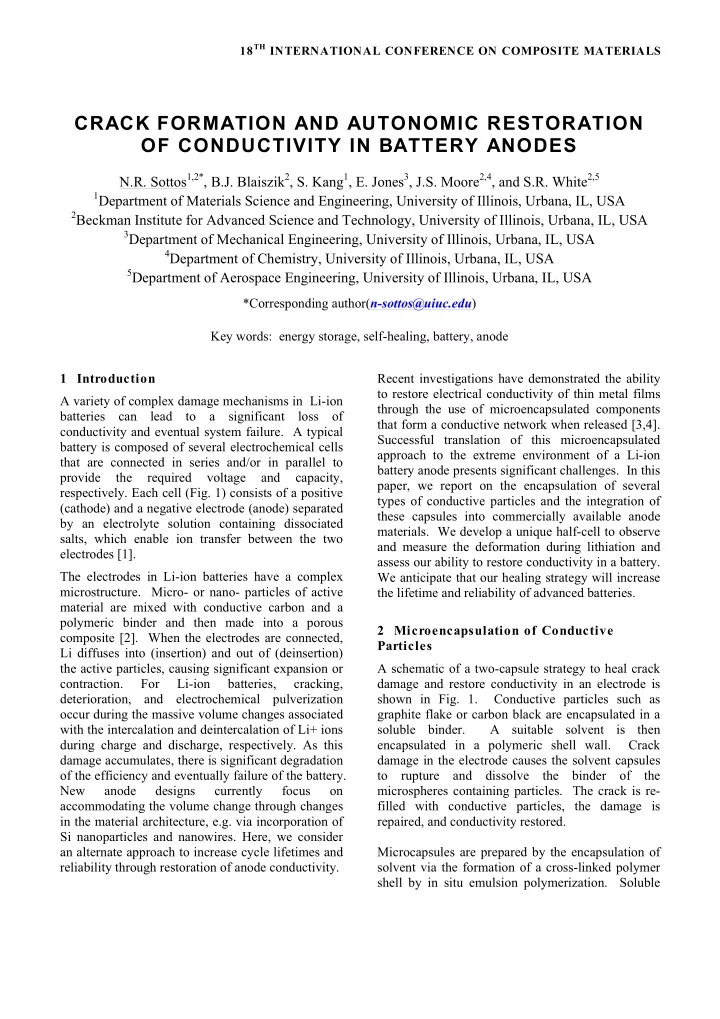

18 TH INTERNATIONAL CONFERENCE ON COMPOSITE MATERIALS CRACK FORMATION AND AUTONOMIC RESTORATION OF CONDUCTIVITY IN BATTERY ANODES N.R. Sottos 1,2* , B.J. Blaiszik 2 , S. Kang 1 , E. Jones 3 , J.S. Moore 2,4 , and S.R. White 2,5 1 Department of Materials Science and Engineering, University of Illinois, Urbana, IL, USA 2 Beckman Institute for Advanced Science and Technology, University of Illinois, Urbana, IL, USA 3 Department of Mechanical Engineering, University of Illinois, Urbana, IL, USA 4 Department of Chemistry, University of Illinois, Urbana, IL, USA 5 Department of Aerospace Engineering, University of Illinois, Urbana, IL, USA *Corresponding author( n-sottos@uiuc.edu ) Key words: energy storage, self-healing, battery, anode 1 Introduction Recent investigations have demonstrated the ability to restore electrical conductivity of thin metal films A variety of complex damage mechanisms in Li-ion through the use of microencapsulated components batteries can lead to a significant loss of that form a conductive network when released [3,4]. conductivity and eventual system failure. A typical Successful translation of this microencapsulated battery is composed of several electrochemical cells approach to the extreme environment of a Li-ion that are connected in series and/or in parallel to battery anode presents significant challenges. In this provide the required voltage and capacity, paper, we report on the encapsulation of several respectively. Each cell (Fig. 1) consists of a positive types of conductive particles and the integration of (cathode) and a negative electrode (anode) separated these capsules into commercially available anode by an electrolyte solution containing dissociated materials. We develop a unique half-cell to observe salts, which enable ion transfer between the two and measure the deformation during lithiation and electrodes [1]. assess our ability to restore conductivity in a battery. The electrodes in Li-ion batteries have a complex We anticipate that our healing strategy will increase microstructure. Micro- or nano- particles of active the lifetime and reliability of advanced batteries. material are mixed with conductive carbon and a polymeric binder and then made into a porous 2 Microencapsulation of Conductive composite [2]. When the electrodes are connected, Particles Li diffuses into (insertion) and out of (deinsertion) the active particles, causing significant expansion or A schematic of a two-capsule strategy to heal crack contraction. For Li-ion batteries, cracking, damage and restore conductivity in an electrode is deterioration, and electrochemical pulverization shown in Fig. 1. Conductive particles such as occur during the massive volume changes associated graphite flake or carbon black are encapsulated in a with the intercalation and deintercalation of Li+ ions soluble binder. A suitable solvent is then during charge and discharge, respectively. As this encapsulated in a polymeric shell wall. Crack damage accumulates, there is significant degradation damage in the electrode causes the solvent capsules of the efficiency and eventually failure of the battery. to rupture and dissolve the binder of the New anode designs currently focus on microspheres containing particles. The crack is re- accommodating the volume change through changes filled with conductive particles, the damage is in the material architecture, e.g. via incorporation of repaired, and conductivity restored. Si nanoparticles and nanowires. Here, we consider an alternate approach to increase cycle lifetimes and Microcapsules are prepared by the encapsulation of reliability through restoration of anode conductivity. solvent via the formation of a cross-linked polymer shell by in situ emulsion polymerization. Soluble
microspheres are fabricated by a solvent evaporation method. Both the microcapsules and microspheres have been successfully incorporated in a Si particle/cellulose binder anode as shown in Fig. 3. A variety of liquid cores, polymer shells, conductive particles, and polymer binders are investigated. We identify promising encapsulated systems based on the ability to survive anode fabrication and coin cell assembly. 3. Crack Observation and Strain Measurement during Lithiation In order to design and assess our self-healing concepts, we need to observe deformation and quantify the strain levels that induce cracking in anodes materials. We have designed and fabricated a custom battery cell (Fig. 4) that enables imaging of the anode during insertion and extraction of Li. The cell is fully sealed with a quartz window for optical Fig. 2. Self-healing concept for battery anodes. access. In future experiments, we plan to quantify the anode strain using a digital image correlation technique [2] and use the cell to establish the feasibility of our healing concept. Fig. 3. PMMA/graphite soluble spheres (red) and EPA filled capsules (blue) in a Si/CMC anode. Fig.1. Schematic of a Li Ion Battery
PAPER TITLE Li reference and counter electrode working electrode Fig. 4. Half-cell for observation and measurement of anode strain during lithiation. References [1] J.M. Tarascon and M. Arrnand, Issues and challenges facing rechargeable lithium batteries. Nature , 414 , p. 359-367, 2001. [2] Y. Qi and S.J. Harris In situ observation of strains during lithiation of a graphite electrode J. of Electrochem. Soc., 157 , A741-747, 2010. [3] S. Odom, et al., Restoration of conductance with TTF-TCNQ charge transfer salts, Adv. Func. Mat. , 20 , 1721-1727, 2010. [4] M. Caruso, et al., Microcapsules containing suspensions of carbon nanotubes, J. Mater. Chem., 19 , 6093, 2009. 3
Recommend
More recommend